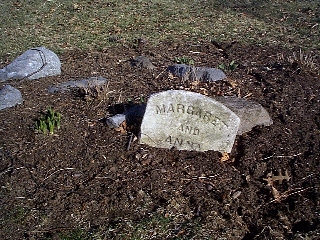 The
Silken Tent
The
Silken Tent
My Letter
to the World -- April, 1999
 The
Silken Tent
The
Silken Tent
My Letter
to the World -- April, 1999
The newsletter of the Association
for Gravestone Studies came today, and I promptly marked the dates for
their annual convention to take place in June in Washington, D.C. It was
nice that the piece came today, because just the other day I finished reading
the most recent issue of Epitaphs, the newsletter of the Berks County
Association for Graveyard Preservation.
My fascination with cemeteries goes back to the year I turned seven. I was walking home from school alone -- the eighth grade girl who usually walked with me was absent -- and I was enjoying the freedom. I hopped up on a low stone retaining wall and pretended it was a high wire. When I got to the corner I made the right angle turn with a smart skip and found myself staring down an alley.
About a block away, behind a high iron fence, I could see what I was sure was a circus tent. Convinced that a high wire artist was at that moment performing there, I followed the gravely path.
When I got to the iron fence I could see that there was only the one tent -- if this were a circus it was small indeed. I slipped between the bars and walked toward it. I could hear someone speaking in a low voice, and murmurs answering him.
I crept up to a large tree beside the tent and peered around. No circus, alas -- just some people gathered around a polished box heaped with flowers. Beyond them, spilling down the hill, were rows and rows of gray stones in all shapes and sizes, some with statues of angels standing on top. And the stones had words -- Sacred to the Memory, or Asleep or Beloved. I thought they were beautiful.
I probably didn't see another cemetery until my grandmother died four years later. By then I knew what the stones were for, and I knew that if you did some simple math you could tell how old the person buried there was when he died. Not far from my grandmother's plot was one for a girl who'd been born the same year I was. She'd died at the age of eight, and her picture, in her white First Communion dress and veil, was right there on the stone.
Since that time I have become something of an expert on things funereal. I know more than any one person needs to know (I'm told) about cemetery design, the architecture of markers, styles and trends in the decoration and information placed there. I can sometimes tell from a glance what decade of what century a particular cemetery was begun, why the stones on one side of a town are gleaming and readable after a century while newer ones a mile away are worn smooth, their stories effaced.
"Oh, Mommy," my daughter once said, "you know so many dead people!" She and her father were following me through the Charles Evans Cemetery in Reading in search of material about the Bissinger Tragedy of 1899. Once, on a visit to the grave site of Edgar Allen Poe in Baltimore, she told a reporter, "We came to visit one of Mommy's friends. He's under a rock." Thirteen now, she sometimes distracts me on family trips through unfamiliar territory, lest I spy a graveyard and insist on stopping.
It's the the human stories lying there that fascinate me -- children who didn't make it to ten, young mothers who died of diseases you don't have to get anymore, patriarchs laid among a succession of three wives, table stones and cradle stones and tiny pillow stones with carved lambs marked only "Stillborn Girl." Gone but not Forgotten, some of them say, but I wonder.
 That's
why Margaret and Anna live with me now. I found them on a visit to my parents'
grave site. On a cloudy spring day I drove up to St. Canicus Cemetery in
Mahanoy City, Pennsylvania. I stopped on Centre Street for some cut flowers
and then went up the windswept hill to this once bustling coal town's seventeen
cemeteries. I put the peonies, which my mother loved best, at her spot,
and took some of the others to where her grandparents and her uncles lay.
That's
why Margaret and Anna live with me now. I found them on a visit to my parents'
grave site. On a cloudy spring day I drove up to St. Canicus Cemetery in
Mahanoy City, Pennsylvania. I stopped on Centre Street for some cut flowers
and then went up the windswept hill to this once bustling coal town's seventeen
cemeteries. I put the peonies, which my mother loved best, at her spot,
and took some of the others to where her grandparents and her uncles lay.
I needed to throw away the paper from the flowers and the breakfast snack I'd had on the way up. I found a trash barrel behind the utility shed. It was a barrel for burning, and the material being used to lift it above the firebed was -- I was appalled -- broken gravestones. One of them, just at the edge of the pile, was the one pictured at left.
It's at least a hundred years old, I can tell. It's broken just below Anna's name, where the iron rods that held it to its plinth ended. This is a common weak spot in a stone -- moisture gets in there, freezes and thaws, and eventually the piece cracks and breaks off if someone leans on it. Any biographical information about the two girls was on the other half, and that was nowhere to be found.
I did walk around for a while looking for it, figuring it might still be set in its place. But the wind picked up, and a soft drizzle began, so I made a decision. I knew I was breaking about a half dozen laws, but I didn't care. I pulled the stone out (the barrel didn't even wobble), picked it up, and heaved it into the trunk of my car.
I have no idea who Margaret and Anna were -- if they were children, or young women, infant twins perhaps. In the three years I've had the stone no one has come looking for it. It rests in my moon garden, and every so often I go out there and think about those girls, about who might have loved them, about who might have missed them. You can see the first shoots of my white tulips and daffodils coming up to the left -- renewed life and abundance beside the symbol of death and loss. Margaret and Anna are gone from the place they should be, but they're no longer forgotten.